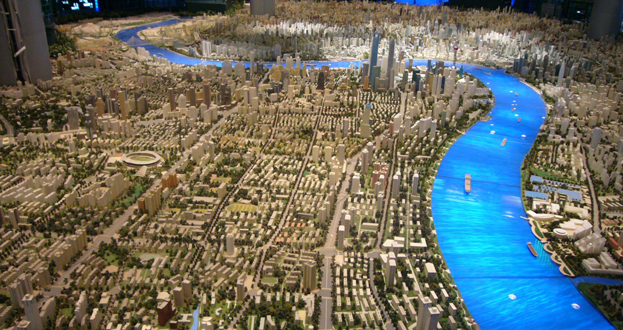
On 7 December 2014, we – the SINGLE Team – visited the Shanghai Urban Planning Exhibition Centre.
We visited the Shanghai Urban Planning Exhibition Centre on 7 December 2014. Despite it being a Sunday afternoon, the Centre was quiet. Among the small number of visitors, most, as far as I could observe, were Western tourists. Since this was the second time I visited the Centre, I spent slightly more than an hour there.
The six-storeyed building which opened in 2000 to welcome the new millennium was divided into various sections with various foci, themes and (clusters of) exhibits: from a historical (audio-visual) account of the metamorphosis of the city to the presentation of a recent ecology-driven development project. I would like to zoom in onto two exhibits in particular.
I used the phrase ‘zoom in’ deliberately, as zooming in was precisely the sensation I got, being there, experiencing.
The first was at the centre of the spacious lobby right after the visitors entered the Centre proper. It was a huge map of Shanghai. However huge it was, the map remained a miniature of the real city and therefore must make do with intricate visualizations of transport networks and spatial segregations. The map, laid down on the lobby floor, invited visitors to step onto it, to stroll over it, to scrutinize it, and quite inevitably to locate themselves. This is where I have been! This is where I am staying…
The other was probably the most spectacular, the centrepiece of the Centre. It was a scale model of the entire city, including all existing and approved structures. This exhibit was designed and constructed in such a way that allowed visitors to stand not only by the sides of the model, but also, through elevated and protruding galleries, over the model. Shanghai was literally under my feet. Like the huge map where I stood on, this model lured me and other visitors to enter, view and locate – indeed, to zoom in.
The ability to zoom in is a privilege, of someone above, having control, overseeing everything, godly, and appreciating the beauty of (technological) creation, order and smooth operation of things. This map and this model scale repeated themselves in various versions throughout the Centre, for instance, as an animated film that shows different parts of Shanghai in a 360-degree manner, or as a miniature of the traditional Shanghai style garden – all contributing to the possibility of zooming in, a sensation of overview and control.
Curiously, there were hardly any representations of humans or human activities.
Recalling the assertion of urban scholars that human communication, links, networks, and so forth are what make a city a city, I found the dehumanized way of presenting Shanghai uncannily revealing; it in fact underscored one, if not the only, major thrust of the Shanghai Urban Planning Exhibition Centre.
I suppose the exhibition is not really about the urban, but about planning – above all, the omnipotence and omnipresence of planning.